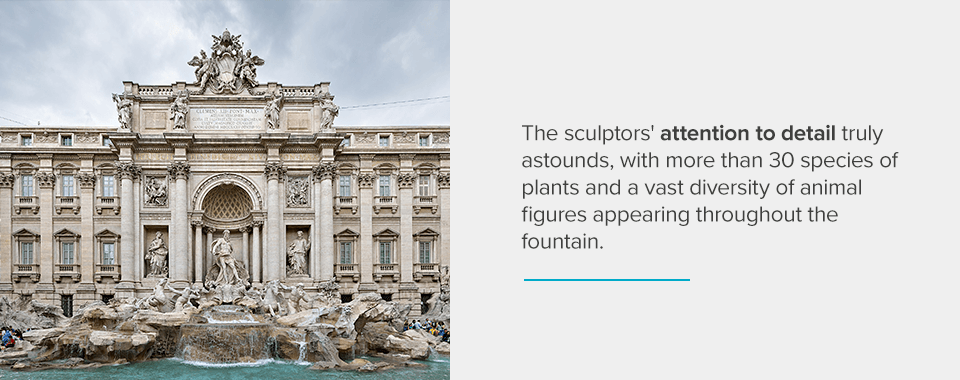
You might be familiar with the Trevi Fountain from its appearance in the iconic 1960 film “La Dolce Vita.” But did you know the Trevi Fountain’s history goes far beyond the silver screen and dates back to the Roman Empire?
Read on to learn about the Trevi Fountain’s history and why it’s one of the most beloved attractions in Rome.
In This Article
- What Is the Trevi Fountain?
- The History of the Trevi Fountain
- Why Do People Toss Coins Into the Trevi Fountain?
- See the Trevi Fountain in Person on a Windstar Cruise
What Is the Trevi Fountain?
The Trevi Fountain is the largest and most well-known of Rome’s many fountains. Constructed in the dramatic, sweeping Baroque style of the 18th century, it measures 49 meters wide and 26 meters high — that’s roughly 160 feet wide and 85 feet high.
Such an enormous fountain needs massive quantities of water. More than 2,824,800 cubic feet of recycled water flows through it every single day.
The fountain’s rather literal name comes from the Latin word “trivium,” which means “intersection of three streets.” Its Italian name, “Fontana di Trevi” translates literally to “Three Street Fountain.”
Where Is the Trevi Fountain?
True to its name, the Trevi Fountain is located at the intersection of three roads:
- De Crocicchi Street
- Poli Street
- Delle Muratte Street
The fountain leans against the rear façade of the Palazzo Poli, which can make it difficult to find if you’re roaming the city on your own.
After you visit the fountain, make sure to stop by these nearby spots before you go:
- Galleria Sciarra: Tucked away within a stone’s throw of the fountain, this hidden gem will transport you out of the Baroque era and into the 19th century. All four walls of this glass-ceilinged courtyard are covered with Giuseppe Cellini’s art nouveau illustrations celebrating the glorification of women.
- The Alchemist’s Door: One of five remaining gates to the former villa of the Marquis Palombara, the Alchemist’s Door (Porta Alchemica, in Italian) is a mysterious portal from the 19th century.
The History of the Trevi Fountain
As the largest fountain in Rome, you’d expect the Trevi Fountain’s history to be just as expansive. And you’d be right. It stretches all the way to ancient days, at the peak of the Roman Empire’s power.
Ancient Rome
You can trace the Trevi Fountain’s history all the way back to around 19 B.C. when it was a simple aqueduct. Built during the reign of Emperor Augustus, it is the only Roman aqueduct that is still functioning today.
According to the legend, Roman general Marcus Agrippa and his soldiers came across a young virgin one day who miraculously made a spring of pure water appear for them to drink. To commemorate the event, Agrippa built the Aqueduct of the Virgin, which distributed water throughout the city.
17th Century
By the 1600s, another fountain stood in the same place. However, Pope Urban VIII ordered its demolition and replacement because he believed it to be insufficiently dramatic.
The pope commissioned Gian Lorenzo Bernini to draw up some possible renovations, but before the project could come to fruition, Pope Urban VIII died and the project was abandoned.
Although Bernini’s original design was never realized, his sketches heavily influenced the future fountain’s construction in the next century.
18th Century
In the 1700s, building and art competitions were popular ways for artists to earn commissions. In 1732, Pope Clement XII, intending to replace the original fountain, organized one such contest between Nicola Salvi and Alessandro Galilei. Although Salvi originally lost to Galilei, he ended up receiving the commission anyway due to the Romans’ objection to a Florentine victory.
Salvi used Bernini’s sketches from the last attempted renovation as inspiration for his design.
Giuseppe Pannini was hired to assist as an architect. Additionally, four other sculptors worked with Salvi on the project:
- Pietro Bracci, who created the central figure of Oceanus
- Filippo della Valle
- Andrea Bergondi
- Giovanni Grossi
Construction began in the 1730s and stretched on for another 30 years. Salvi died in 1751, so he was unable to see the project through to completion, but Pannini finished the fountain in 1762 with minor alterations to the original design.
The final design features a central sculpture of the Titan god Oceanus on a chariot pulled by two Triton-led winged horses. One horse is calm while the other reels against his reins, representing the dual nature of the sea. Oceanus is also flanked on either side by two niches containing the allegorical figures of:
- Left: Abundance, who carries a basket filled with fruit and stands next to an overflowing urn.
- Right: Salubrità (Health), who holds a spear in one hand and a cup in another. A snake winds up her right side to drink out of the cup.
Draw your eyes above these figures and you’ll see two bas-relief panels depicting the legend of the Virgin. On the left side are Agrippa and his men while the right panel features the Virgin, who points to the miraculous spring of pure water.
Keep looking up — atop the palazzo’s columns are four more allegorical statues depicting:
- Abundance of fruit
- Wealth of autumn
- Amenity of the gardens
- Fertility of the fields
Between all these figures is a massive stone coat of arms flanked by two cherubs. But that’s not all you’ll see. The sculptors’ attention to detail truly astounds, with more than 30 species of plants and a vast diversity of animal figures appearing throughout the fountain.

Present Day
The fountain has appeared in and inspired various films throughout the last century, including:
- 1953: “Roman Holiday”
- 1954: “Three Coins in the Fountain”
- 1960: “La Dolce Vita”
- 1998: “Sabrina Goes to Rome”
- 2003: “The Lizzie McGuire Movie”
In 2013, Italian fashion house Fendi sponsored a 2.2 million euro renovation project to restore the aging fountain to its former glory. The project, which lasted 20 months, was the largest restoration ever done on the fountain.
Why Do People Toss Coins Into the Trevi Fountain?
Back in ancient Rome, people often threw small gifts into fountains and wells as an offering to the gods. Nowadays, though, people throw coins into the Trevi Fountain to guarantee a safe return to the Eternal City.
But you have to follow a few specific steps to do it right. Here’s how you can participate in this time-honored tradition:
- Hold your coin in your right hand.
- Turn your back to the fountain.
- Toss the coin over your left shoulder and into the water.
According to legend, if you throw two coins, you’ll find love. If you toss three, your future marriage is assured.
You might wonder what happens to all those coins. Since 2007, the city has donated all the revenue from the fountain — nearly 1.5 million euros per year — to charity.
See the Trevi Fountain in Person on a Windstar Cruise

If you’re dreaming of traveling to Italy, you can count on Windstar Cruises to take you there in unmatched style and elegance. Our small cruise ships provide an intimate traveling experience you won’t find on a larger vessel. With no crowds and personalized service from our attentive crew, you’ll never want to return home.
Browse our Italian cruise offerings on our site to learn more, and feel free to contact us with any questions.





















































